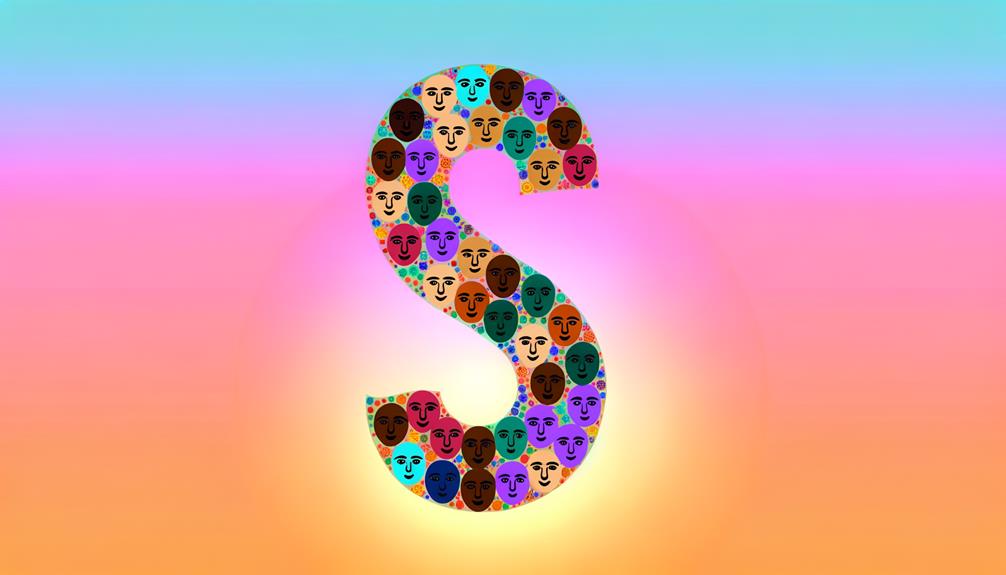What is the Meaning of the Semicolon Symbol in Mental Health?
The semicolon symbol in mental health is rooted in Project Semicolon, founded by Amy Bleuel in 2013 to honor her father who died by suicide. It signifies a pause in a sentence rather than an end, symbolizing resilience and the continuation of one's life story amid struggles.
The symbol fosters a message of hope and persistence, promoting open dialogue about mental health and reducing stigma. Often adopted as tattoos, semicolons serve as personal reminders of strength and survival.
This simple mark raises awareness, uniting communities in empathy and support. Explore further to understand its profound impact on mental health advocacy.

Key Takeaways
- Represents a pause in life, signifying resilience and the choice to continue despite struggles.
- Honors the memory of Amy Bleuel's father, who died by suicide.
- Symbolizes hope, strength, and a commitment to persist through mental health challenges.
- Fosters empathy, support, and encourages open dialogue about mental health.
- Tattoos of the semicolon act as personal reminders of perseverance and reduce mental health stigma.
Origins of Project Semicolon

Project Semicolon, founded in 2013 by Amy Bleuel, emerged as a movement dedicated to providing hope and support for individuals grappling with mental health issues. It was established to honor Bleuel's father, who died by suicide, and to address the pervasive stigma surrounding mental health struggles.
The initiative quickly gained momentum, resonating with a global audience by offering a platform for individuals to share their stories and connect with others facing similar challenges. By creating a community rooted in empathy and understanding, Project Semicolon sought to remind those suffering from mental illness that their lives and stories are not over.
The organization's mission underscores the importance of mental health awareness, fostering a supportive environment for those in need.
Symbolism of the Semicolon
The semicolon has become a powerful symbol of hope and continuity in the context of mental health, representing a pause rather than an end in an individual's life story. This punctuation mark has transcended its grammatical origins to embody resilience and the choice to continue despite life's challenges.
The imagery associated with the semicolon includes:
- A lifeline extended: signifying the continuation of one's journey
- A bridge over troubled waters: illustrating overcoming obstacles
- A moment of breath: symbolizing taking time to gather strength
- A commitment to persist: denoting the decision to keep moving forward
- A silent but profound statement: representing unspoken battles and inner strength
Understanding its symbolism helps to foster empathy and support for those facing mental health struggles.
Mental Health Awareness

Mental health awareness is essential in fostering an environment where open dialogue is encouraged, allowing individuals to share their experiences without fear of judgment.
By actively working together to break the stigma surrounding mental health issues, communities can create more inclusive and supportive spaces.
Additionally, strong support systems play a critical role in providing the necessary resources and assistance to those in need.
Importance of Open Dialogue
Open dialogue is crucial for fostering a supportive environment where individuals feel safe to discuss their mental health challenges. Creating spaces for open conversation can lead to a multitude of positive outcomes:
- Increased Awareness: People become more knowledgeable about mental health issues and the resources available.
- Early Intervention: Symptoms can be recognized and addressed before they escalate.
- Empowerment: Individuals feel more in control and less isolated in their experiences.
- Support Networks: Stronger connections are formed, providing both emotional and practical support.
- Reduced Misunderstanding: Myths and misconceptions about mental health are dispelled.
Breaking Stigma Together
In tandem with increasing mental health awareness, breaking the stigma associated with mental health conditions is essential for fostering an inclusive and supportive community. Stigma often stems from misconceptions and a lack of understanding, leading to discrimination and social isolation.
By promoting education and open dialogue, we can dispel myths and encourage empathy towards those affected by mental health issues. Public figures and campaigns that highlight personal stories play a vital role in normalizing conversations about mental health.
Additionally, language matters; using non-judgmental and respectful terminology can greatly alter perceptions. Collective efforts to reduce stigma not only improve individual well-being but also create a society where seeking help is seen as a sign of strength, not weakness.
Support Systems Matter
The presence of robust support systems is crucial in promoting mental health awareness and facilitating recovery for individuals facing mental health challenges. Strong support networks provide the emotional, social, and practical assistance necessary for navigating treatment and recovery.
Critical elements of effective support systems include:
- Close family and friends: Offer continuous emotional support and understanding.
- Mental health professionals: Provide expert guidance, therapy, and interventions.
- Support groups: Create a shared space for individuals to express and manage their struggles.
- Workplace initiatives: Foster inclusive environments and mental health resources.
- Community programs: Offer outreach services, education, and support.
These components collectively contribute to a detailed framework that encourages resilience and fosters a culture of empathy and acceptance in mental health care.
Stories of Survival
Countless individuals have found strength and hope through the semicolon symbol, sharing their powerful stories of survival in the face of mental health challenges. These narratives, often marked by profound struggles with depression, anxiety, and suicidal thoughts, illuminate the resilience and determination of those who refuse to let their stories end.
The semicolon, a symbol of continuation, represents a choice to continue living despite seemingly insurmountable obstacles. Personal accounts reveal how this small punctuation mark has become a beacon of solidarity and understanding, fostering a sense of community among those affected by mental health issues.
Semicolon Tattoos

Semicolon tattoos have emerged as powerful symbols of continuation and resilience, representing a choice to keep moving forward despite life's challenges.
These tattoos not only serve as personal emblems of empowerment but also play an important role in raising mental health awareness.
Symbol of Continuation
Often seen as a powerful emblem of resilience and perseverance, semicolon tattoos symbolize the choice to continue one's story despite life's challenges. This small punctuation mark signifies that the story could have ended, but the author chose to continue.
For individuals facing mental health struggles, this symbol represents a commitment to their journey and the hope for better times ahead.
The semicolon tattoo often evokes the following imagery:
- A pause and continuation: A moment of contemplation followed by the decision to move forward.
- Inner strength: The courage to persist despite adversity.
- Personal journey: Each tattoo tells a unique story of survival.
- Hope and recovery: An emblem of optimism and healing.
- Community and support: A sign of solidarity among those who share similar experiences.
Personal Empowerment Tattoos
Embodying a profound sense of personal empowerment, semicolon tattoos serve as a validation of an individual's resilience and strength in the face of mental health challenges. These tattoos symbolize a commitment to continue one's journey despite adversities, becoming a visual reminder of perseverance and hope. Individuals who choose to adorn their bodies with this meaningful symbol often find solace and motivation in its presence, reinforcing their decision to keep moving forward.
| Benefits | Symbolism | Purpose |
|---|---|---|
| Emotional healing | Continuation of life | Personal empowerment |
| Sense of community | Overcoming adversity | Reminder of resilience |
| Daily motivation | Hope and recovery | Validation of strength |
| Personal expression | Mental health awareness | Commitment to self-care |
| Visual reminder | Endurance | Strength through challenges |
Mental Health Awareness
Symbolizing solidarity and understanding, semicolon tattoos play an integral role in fostering mental health awareness and advocacy. These tattoos serve as a poignant reminder that mental health struggles are part of many individuals' lives, and they emphasize the importance of continuing one's story despite hardships.
The semicolon represents a pause, a choice to continue rather than end a sentence, mirroring the decision to persevere through mental health challenges.
- Personal Stories: Each tattoo tells a unique narrative of resilience.
- Community Support: They create a sense of belonging and shared experience.
- Public Awareness: Visible symbols that spark conversations about mental health.
- Stigma Reduction: Promote understanding and acceptance of mental health issues.
- Empowerment: Encourage individuals to take control of their mental health journey.
This imagery provides a powerful visual metaphor for mental health advocacy.
Community Support
The semicolon symbol has fostered a supportive and understanding community for individuals facing mental health challenges. This emblem serves as a unifying beacon, drawing together people from diverse backgrounds who share similar experiences.
Through online forums, social media groups, and local meetups, the semicolon community offers a safe space where individuals can share their stories, seek advice, and provide emotional support. The collective empathy within this community mitigates feelings of isolation, encouraging open conversations about mental health struggles.
Professional mental health advocates and peer supporters often participate, offering both clinical insights and lived experiences. The semicolon community exemplifies the power of collective support, demonstrating how shared symbols can cultivate resilience and solidarity among those navigating mental health journeys.
Spreading Hope

Frequently serving as a poignant reminder of perseverance, the semicolon symbol plays a crucial role in spreading hope among individuals facing mental health challenges. Its simple yet powerful representation can inspire resilience and encourage open conversations about mental health struggles.
The semicolon signifies that one's story is not over, offering a sense of continuity and renewed purpose.
- Tattooed semicolons: Personal symbols of survival and commitment to continue
- Social media posts: Sharing stories and fostering a sense of community and understanding
- Educational workshops: Promoting mental health awareness and support networks
- Artistic expressions: Visual reminders through paintings, drawings, and crafts
- Public campaigns: Raising awareness and reducing stigma associated with mental health issues
Together, these efforts create a supportive environment that empowers individuals to seek help and remain hopeful.
Future Impact
Anticipating the future impact of the semicolon symbol in mental health advocacy, it is poised to further dismantle stigma and foster an inclusive dialogue around mental well-being. As awareness grows, the symbol may become a universal emblem of resilience and solidarity, encouraging individuals to share their experiences without fear of judgment.
This expanded recognition can lead to increased funding for mental health resources and more robust support systems. Additionally, the semicolon can influence policy changes by highlighting the necessity for mental health education and accessible care. By continuing to symbolize hope and continuity, the semicolon stands to empower more people to seek help and advocate for themselves and others, thereby creating a more understanding and compassionate society.
Conclusion
The semicolon, as a symbol, transcends its grammatical roots to embody resilience and hope in the world of mental health. Born from Project Semicolon, it represents not an end but a continuation, a powerful metaphor for life's unbroken narrative despite adversity.
Through tattoos and shared stories, it fosters a community of support and awareness. Therefore, the semicolon not only marks a pause in writing but also serves as a beacon, illuminating paths towards healing and future impact.






